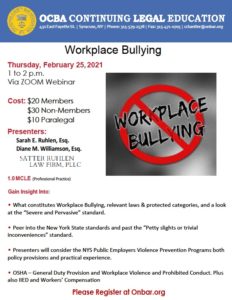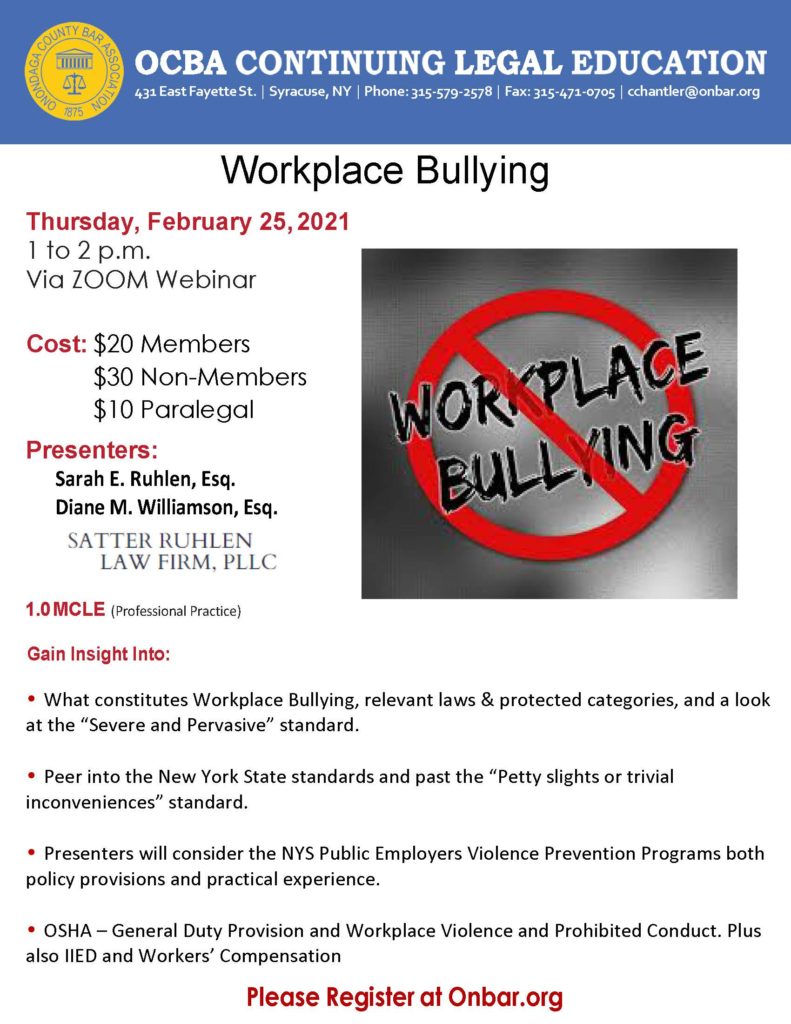Please note that the information contained in this post is for informational purposes and is not to be considered legal advice. This blog post does not create or imply an attorney-client relationship. If you would like to discuss your particular circumstances with us, please set up a consultation by contacting the Satter Ruhlen Law Firm at 315-471-0405 or through our website (https://www.satterlaw.com/contact-us/). We look forward to walking you through your workplace rights.
The pandemic has closed a lot of doors. Currently about 12.6 million people are unemployed in the U.S. Everyone who is still employed dreads getting the infamous Reduction In Force [“RIF”] or “pink slip.” Here’s what the Employer owes you under Federal and State WARN Acts if you get “RIF’d”:
The Federal Worker Adjustment and Retraining Notification Act [“WARN”] (23 U.S.C. §2101 et seq.), generally, requires Employers with 100 or more full-time Employees to provide written notice to affected Employees, the State, and your Union president at least 60 days prior to a plant closing or mass layoff. Penalties for violations can include back pay and benefits for each Employee up to 60 days, as well as civil penalties. The deadline to file a lawsuit varies from jurisdiction to jurisdiction (for more specificity, call a qualified labor and employment attorney in your jurisdiction!)
Now the bad news: Temps and strikers do not get WARN protection. A plant closing must involve at least 50 Workers at a single site, or a closing plus a layoff that, combined, affects 50 or more Workers. A mass layoff involves either 500 or more Workers at a single site during a 30-day period, or layoffs of 50-499 Workers at a single site if the layoffs affect at least 33% of the Workers at that site. A temporary layoff can trigger WARN obligations if it exceeds 6 months. A 50% or more reduction in hours for 50 or more Workers may also require an Employer to provide WARN notice.
Under normal circumstances, the New York State WARN Act [“NY WARN”] adds an additional 30 days to the notice requirement for some Employers, for a total required notice of 90 days. New York Labor Law §§ 860 et seq. NY Warn applies to businesses with only 50 or more full time Workers. Under NY Warn, the Employer must provide notice not only for plant closings and mass layoffs, but also if the plant is relocating, or if 25 or more Workers experience a 50% reduction in hours.
But on April 17, 2020, Governor Cuomo signed Executive Order No. 202.19, relaxing some of those requirements for Employers who initially laid off Employees (and complied with WARN the first time) and then hired them back after receiving Paycheck Protection Program (PPP) loans. If Employers institute another round of layoffs after receiving PPP funding, they only have to provide notice “as soon as practicable.”
On November 11, 2020, Governor Cuomo signed an amendment to the NY WARN that additionally requires Employers to provide notice to chief officials of local government and school districts, and to every locality that provides police, fire prevention, EMS or ambulance, or other emergency services to the job site.
What about furloughs? Furloughs involve reduced hours or days for a finite amount of time. So whether a furlough triggers Federal or NYS WARN depends on its duration, how many Employees are affected, and how many hours are reduced. Under WARN, if a furlough originally intended to last three months is extended to seven months due to unforeseeable circumstances, the Employer has to give notice when it realizes it needs to extend the duration. Employers aren’t supposed to be able to play games with the timing and extent of their layoffs to avoid WARN obligations. It’s complicated, but there’s an “aggregation” rule that is supposed to stop Employers from gaming the system by implementing staggered layoffs.
Even if your layoff fits the above circumstances, there are some reasons the Employer may not be required to provide you notice: the notice period can be shortened or bypassed under three exceptions: the “faltering company” exception, the “unforeseeable business circumstance” exception, and the “natural disaster” exception.
The “faltering company” exception is available when advance notice to Employees would interfere with the company’s ability to obtain new capital or business that could help the company avoid a shutdown or layoff. 20 CFR §§639.9(a)(3)-(4). The Employer has to have a reasonable, good faith belief that the notice would interfere with, for example, its ability to secure a loan.
The “unforeseeable business circumstances” exception occurs when a “sudden, dramatic, and unexpected action or condition outside of the Employer’s control” causes a layoff or closure. 20 CFR §639.9(b)(1). For example, the unexpected cancellation of a lucrative contract could be an unforeseeable business circumstance. The unforeseeability is defined as “reasonable business judgment” at the time of the occurrence—not by a court looking at the situation in retrospect. An Employer is required to give as much notice as practicable when there is an “unforeseeable business circumstance” layoff.
The “natural disaster” exception applies if a layoff is directly caused by a natural disaster. 20 CFR §693.9(c). For example, if a tornado destroys a manufacturing plant, resulting in the Workers there being laid off, the exception applies. But if a tornado leaves the plant standing and wipes out a lot of other businesses, causing an economic downturn, the “natural disaster” exception does not apply because the tornado is not the direct cause of the lack of work.
A Florida court recently pondered whether the COVID-19 pandemic constitutes an unforeseeable circumstance, natural disaster, or special financial circumstance that would excuse an Employer from providing notice. In Benson et al. v. Enterprise, et al., the court concluded that COVID-19 might be a natural disaster, but that the layoff in question was not a direct result of the pandemic. 6:20-cv-00891 (MD Fla. Jan. 4, 2021). Thus, the Employer could not resort to the “natural disaster” exception. But the parties are still litigating –further discovery is required to determine whether the pandemic is an “unforeseeable business circumstance.” So, could a state ordering all businesses to close for three months constitute an unforeseeable business circumstance? You can bet your hat Employers will argue it does.
Bottom line, Federal and State WARN acts are designed to give you a little safety net in the event of an extended layoff or plant closing. It won’t make you rich, but it may help you get through the winter. If you think you’ve been RIFfed without proper notification, call a qualified labor and employment attorney in your jurisdiction to learn more about your rights.




